2007 MITSUBISHI LANCER EVOLUTION coolant temperature
[x] Cancel search: coolant temperaturePage 543 of 1449

MPI -TroubleshootingMPI -Troubleshooting13A-11
CONFIRMING FREEZE FRAME DATA
When the engine-ECU detects a malfunction and stores a diagnosis code, it also stores a current status
of the engine. This function is called “Freeze frame” data. By analyzing this “Freeze frame” data with
MUT-II, an effective troubleshooting can be performed.
NOTE
If mulfunctions have been detected in multiple systems, engine-ECU stores one malfunction only, which
has been detected first.
Item No.Data itemUnit/StateItem No.Data itemUnit/State
21Engine coolant temperature
sensor_C81Learn value%
22Crank angle sensorr/min82Feedback%
24Vehicle speedkm/h87Engine load%
FAIL-SAFE FUNCTION REFERENCE TABLE
When the main sensor malfunctions are detected by the diagnosis function, the vehicle is controlled
by means of the pre-set control logic to maintain safe conditions for driving.
Malfunctioning itemControl contents during malfunction
Air flow sensor1. Uses the throttle position sensor signal and engine speed signal (crank angle sensor
signal) to take reading of the basic injector drive time and basic ignition timing from
the pre-set mapping.
2. Fixes the idle speed control servo in the appointed position so idle control is not
performed.
Intake air temperature
sensorControls as if the intake air temperature is 25_C.
Throttle position
sensorNo increase in fuel injection amount during acceleration due to the throttle position sensor
signal.
Engine coolant
temperature sensor1. Controls as if the engine coolant temperature is 80_C.
(Even after sensor signal is correctly recovered, continues until the ignition switch
is set to the “LOCK” (OFF) position.)
2. Rotates radiator fan and condenser fan at high speed.
Camshaft position
sensor1. Inject all fuel cylinders simultaneously. (However, when the No.1 cylinder top dead
centre is not detected at all after the ignition switch is turned to “ON” position.)
2. Shuts off fuel supply after 4 seconds have passed since a failure was detected.
(However, when the No.1 cylinder top dead centre is not detected at all after the
ignition switch is turned to “ON” position.)
Barometric pressure
sensorControls as if the barometric pressure is 101 kPa.
Detonation sensorSwitches the ignition timing from ignition timing for super petrol to ignition timing for standard
petrol.
Alternator FR terminalDoes not control the output of the alternator according to an electrical load. (works as a
normal alternator)
Page 544 of 1449

MPI -Troubleshooting13A-12
INSPECTION CHART FOR DIAGNOSIS CODES
Code No.Diagnosis itemReference page
P0100Air flow sensor system13A-13
P0105Barometric pressure sensor system13A-15
P0110Intake air temprature sensor system13A-16
P0115Engine coolant temperature sensor system13A-19
P0120Throttle position sensor system13A-21
P0130Oxygen sensor (front) system13A-24
P0135Oxygen sensor heater (front) system13A-26
P0136Oxygen sensor (rear) system13A-27
P0141Oxygen sensor heater (rear) system13A-29
P0201No.1 injector system13A-30
P0202No.2 injector system13A-31
P0203No.3 injector system13A-32
P0204No.4 injector system13A-33
P0325Detonation sensor system13A-34
P0335Crank angle sensor system13A-35
P0340Camshaft position sensor system13A-37
P0403EGR control solenoid valve system13A-39
P0443Purge control solenoid valve system13A-41
P0500Vehicle speed sensor system13A-43
P0505Idle speed control system13A-44
P0551Power steering fluid pressure switch system13A-46
P1104Waste gate solenoid valve system13A-47
P1105Fuel pressure control valve system13A-48
P1500Alternator FR terminal system13A-49
P1603Battery backup line malfunction13A-50
P1610Immobilizer system13A-51
Page 551 of 1449

MPI -Troubleshooting13A-19
Code No. P0115 Engine coolant temperature sensor
systemProbable cause
Inspection Range
DAfter setting the ignition switch to the “ON” position, or 2 seconds after
completion of engine start.
Evaluation Conditions
DWhen the sensor output voltage is more than 4.6 V for 4 seconds
(Equivalent to water temperature of less than - 45_C)
or
DWhen the sensor output voltage is less than 0.1 V for 4 seconds (Equivalent
to water temperature of more than 140_C)DEngine coolant temperature sensor malfunction
DEngine coolant temperature sensor circuit
disconnection and short-circuit or connector contact
defect
DEngine-ECU malfunction
Inspection Range
DIgnition switch: ON
DThe engine speed is approximately 50 r/min or more.
Evaluation Conditions
DFrom less than 1.6 V (Equivalent to water temperature of more than 40_C),
the sensor output voltage rises to more than 1.6 V (Equivalent to water
temperature of less than 40_C)
DThe sensor output voltage is more than 1.6 V for 5 minutes
OK
To the next page
OK
Measure at the B-118 engine coolant
temperature sensor connector.
DDisconnect the connector and
measure at the sensor side.
DResistance between terminals No.
1 and No. 2
OK:Water temperature - 20_C
14 - 17 kΩ
Water temperature 0_C
5.1 - 6.5 kΩ
Water temperature 20_C
2.1 - 2.7 kΩ
Water temperature 40_C
0.9 - 1.3 kΩ
Water temperature 60_C
0.48 - 0.68 kΩ
Water temperature 80_C
0.26 - 0.36 kΩNGReplace the engine coolant
temperature sensor.
NG
Check the following connector:
B-118NG
Repair
MUT-IIData list
DNo. 21 Engine coolant
temperature sensor
OK:When cool, more or less
the same as the ambient
temperature (air tempera-
ture) When warm
80 - 120_COKIntermittent malfunction
(Refer to GROUP 00 - Points to Note
for Intermittent Malfunctions.)
Page 552 of 1449
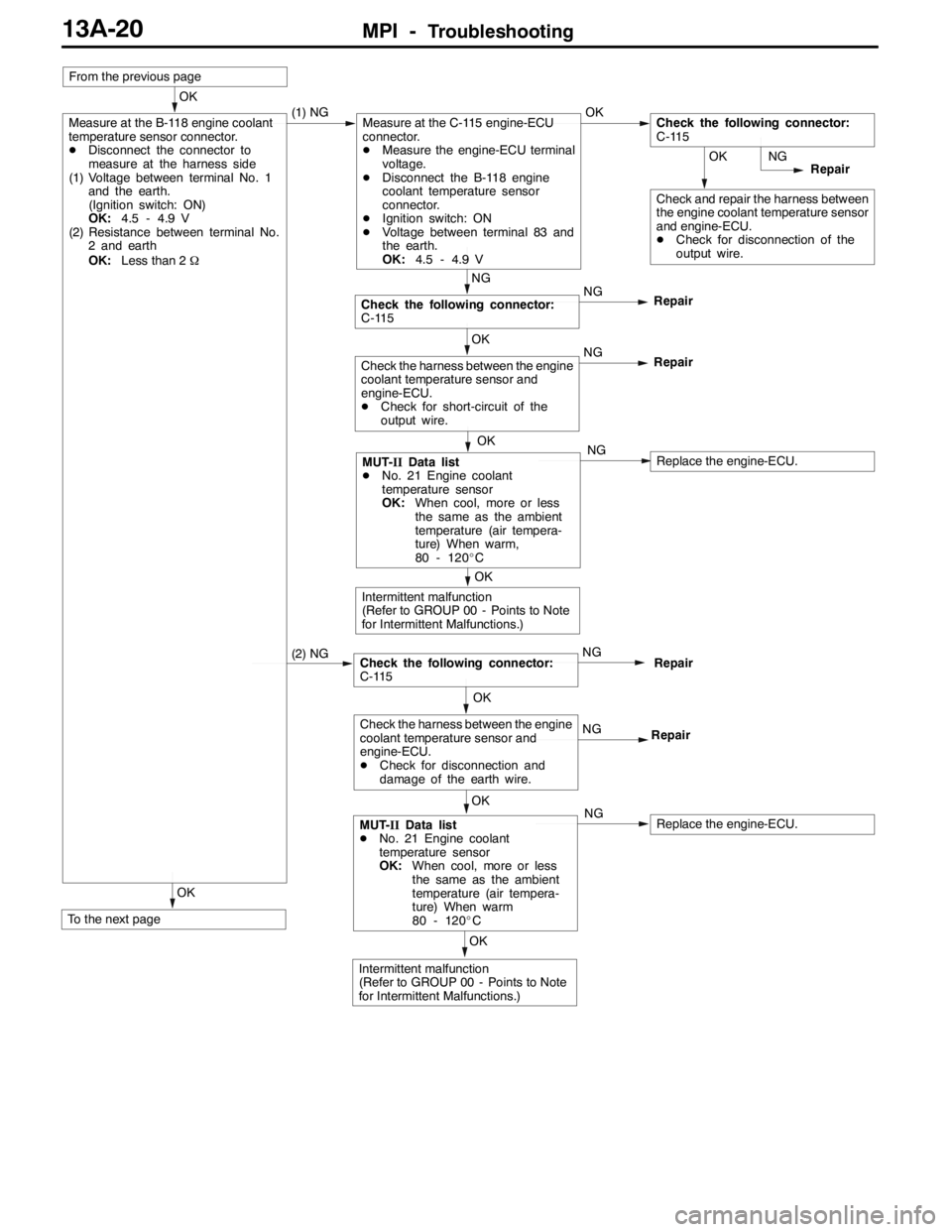
MPI -Troubleshooting13A-20
OK
To the next page
OK
Intermittent malfunction
(Refer to GROUP 00 - Points to Note
for Intermittent Malfunctions.)
OK
MUT-IIData list
DNo. 21 Engine coolant
temperature sensor
OK:When cool, more or less
the same as the ambient
temperature (air tempera-
ture) When warm
80 - 120_CNGReplace the engine-ECU.
OK
Check the harness between the engine
coolant temperature sensor and
engine-ECU.
DCheck for disconnection and
damage of the earth wire.NG
Repair
Check the following connector:
C-115NGRepair (2) NG
OK
Intermittent malfunction
(Refer to GROUP 00 - Points to Note
for Intermittent Malfunctions.)
OK
MUT-IIData list
DNo. 21 Engine coolant
temperature sensor
OK:When cool, more or less
the same as the ambient
temperature (air tempera-
ture) When warm,
80 - 120_CNGReplace the engine-ECU.
OK
Check the harness between the engine
coolant temperature sensor and
engine-ECU.
DCheck for short-circuit of the
output wire.NG
Repair
NG
Check the following connector:
C-115NG
Repair
OK
Check and repair the harness between
the engine coolant temperature sensor
and engine-ECU.
DCheck for disconnection of the
output wire.NG
Repair
OK
Measure at the B-118 engine coolant
temperature sensor connector.
DDisconnect the connector to
measure at the harness side
(1) Voltage between terminal No. 1
and the earth.
(Ignition switch: ON)
OK:4.5 - 4.9 V
(2) Resistance between terminal No.
2 and earth
OK:Less than 2Ω(1) NGMeasure at the C-115 engine-ECU
connector.
DMeasure the engine-ECU terminal
voltage.
DDisconnect the B-118 engine
coolant temperature sensor
connector.
DIgnition switch: ON
DVoltage between terminal 83 and
the earth.
OK:4.5 - 4.9 VOKCheck the following connector:
C-115
From the previous page
Page 553 of 1449
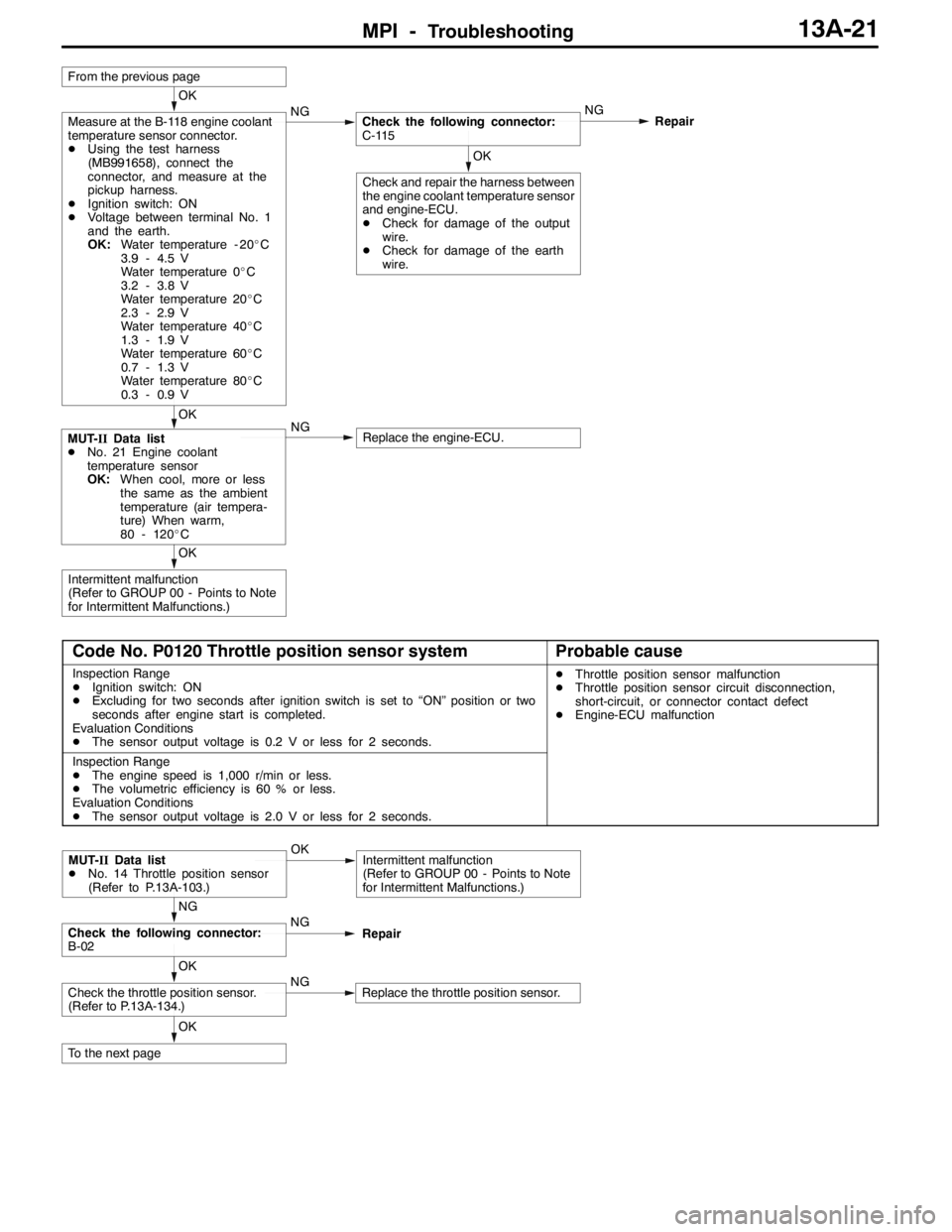
MPI -Troubleshooting13A-21
OK
Intermittent malfunction
(Refer to GROUP 00 - Points to Note
for Intermittent Malfunctions.)
OK
MUT-IIData list
DNo. 21 Engine coolant
temperature sensor
OK:When cool, more or less
the same as the ambient
temperature (air tempera-
ture) When warm,
80 - 120_CNGReplace the engine-ECU.
OK
Check and repair the harness between
the engine coolant temperature sensor
and engine-ECU.
DCheck for damage of the output
wire.
DCheck for damage of the earth
wire.
OK
Measure at the B-118 engine coolant
temperature sensor connector.
DUsing the test harness
(MB991658), connect the
connector, and measure at the
pickup harness.
DIgnition switch: ON
DVoltage between terminal No. 1
and the earth.
OK:Water temperature - 20_C
3.9 - 4.5 V
Water temperature 0_C
3.2 - 3.8 V
Water temperature 20_C
2.3 - 2.9 V
Water temperature 40_C
1.3 - 1.9 V
Water temperature 60_C
0.7 - 1.3 V
Water temperature 80_C
0.3 - 0.9 VNGCheck the following connector:
C-115NG
Repair
From the previous page
Code No. P0120 Throttle position sensor systemProbable cause
Inspection Range
DIgnition switch: ON
DExcluding for two seconds after ignition switch is set to “ON” position or two
seconds after engine start is completed.
Evaluation Conditions
DThe sensor output voltage is 0.2 V or less for 2 seconds.DThrottle position sensor malfunction
DThrottle position sensor circuit disconnection,
short-circuit, or connector contact defect
DEngine-ECU malfunction
Inspection Range
DThe engine speed is 1,000 r/min or less.
DThe volumetric efficiency is 60 % or less.
Evaluation Conditions
DThe sensor output voltage is 2.0 V or less for 2 seconds.
OK
To the next page
OK
Check the throttle position sensor.
(Refer to P.13A-134.)NGReplace the throttle position sensor.
NG
Check the following connector:
B-02NG
Repair
MUT-IIData list
DNo. 14 Throttle position sensor
(Refer to P.13A-103.)OKIntermittent malfunction
(Refer to GROUP 00 - Points to Note
for Intermittent Malfunctions.)
Page 556 of 1449
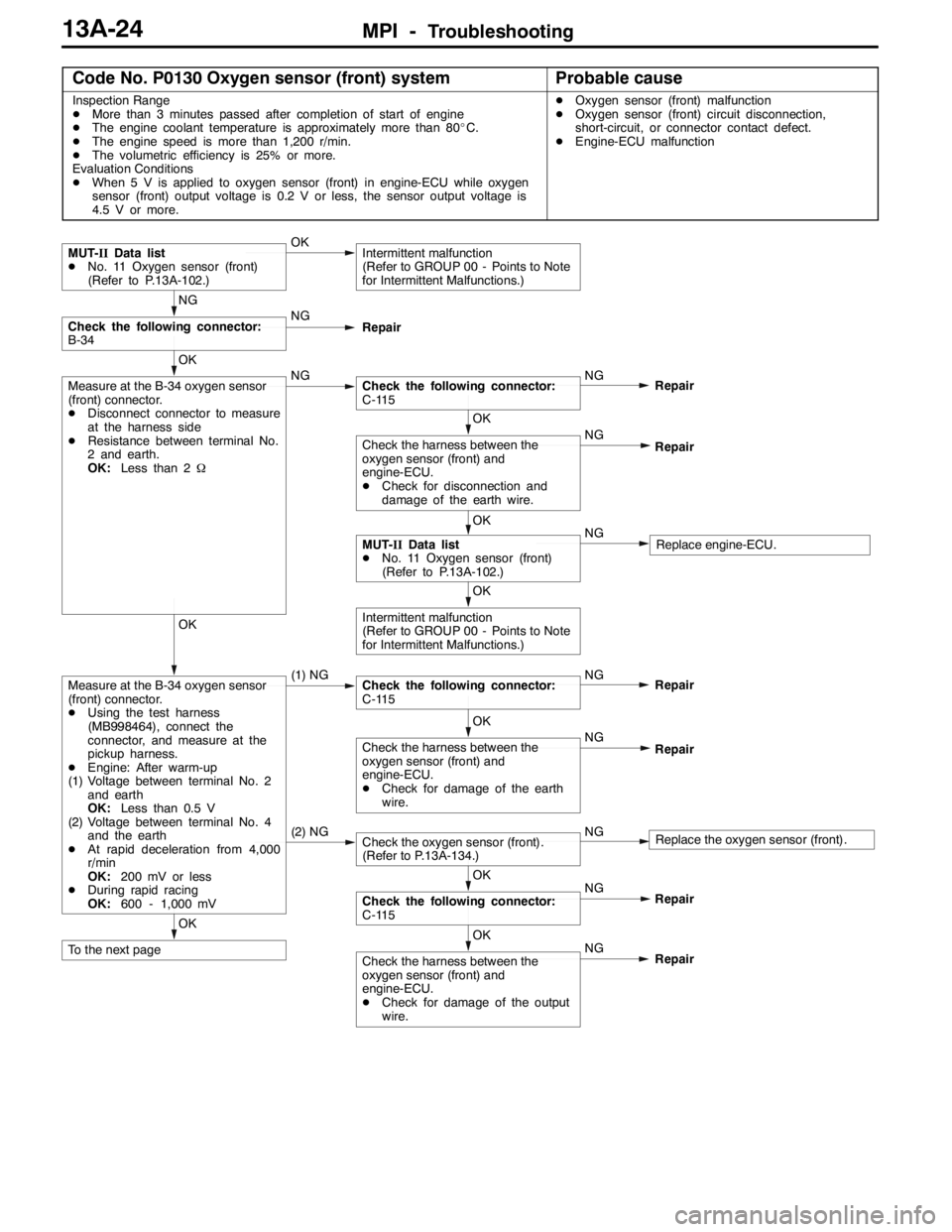
MPI -Troubleshooting13A-24
Code No. P0130 Oxygen sensor (front) systemProbable cause
Inspection Range
DMore than 3 minutes passed after completion of start of engine
DThe engine coolant temperature is approximately more than 80_C.
DThe engine speed is more than 1,200 r/min.
DThe volumetric efficiency is 25% or more.
Evaluation Conditions
DWhen 5 V is applied to oxygen sensor (front) in engine-ECU while oxygen
sensor (front) output voltage is 0.2 V or less, the sensor output voltage is
4.5 V or more.DOxygen sensor (front) malfunction
DOxygen sensor (front) circuit disconnection,
short-circuit, or connector contact defect.
DEngine-ECU malfunction
OK
To the next pageOK
Check the harness between the
oxygen sensor (front) and
engine-ECU.
DCheck for damage of the output
wire.NG
Repair NG
OK
Check the following connector:
C-115Repair
(2) NGCheck the oxygen sensor (front).
(Refer to P.13A-134.)NGReplace the oxygen sensor (front).
OK
Check the harness between the
oxygen sensor (front) and
engine-ECU.
DCheck for damage of the earth
wire.NG
Repair
OK
Measure at the B-34 oxygen sensor
(front) connector.
DUsing the test harness
(MB998464), connect the
connector, and measure at the
pickup harness.
DEngine: After warm-up
(1) Voltage between terminal No. 2
and earth
OK:Less than 0.5 V
(2) Voltage between terminal No. 4
and the earth
DAt rapid deceleration from 4,000
r/min
OK:200 mV or less
DDuring rapid racing
OK:600 - 1,000 mV(1) NGCheck the following connector:
C-115NG
Repair
OK
Intermittent malfunction
(Refer to GROUP 00 - Points to Note
for Intermittent Malfunctions.)
OK
MUT-IIData list
DNo. 11 Oxygen sensor (front)
(Refer to P.13A-102.)NGReplace engine-ECU.
OK
Check the harness between the
oxygen sensor (front) and
engine-ECU.
DCheck for disconnection and
damage of the earth wire.NG
Repair
OK
Measure at the B-34 oxygen sensor
(front) connector.
DDisconnect connector to measure
at the harness side
DResistance between terminal No.
2 and earth.
OK:Less than 2ΩNGCheck the following connector:
C-115NG
Repair
NG
Check the following connector:
B-34NG
Repair
MUT-IIData list
DNo. 11 Oxygen sensor (front)
(Refer to P.13A-102.)OKIntermittent malfunction
(Refer to GROUP 00 - Points to Note
for Intermittent Malfunctions.)
Page 558 of 1449
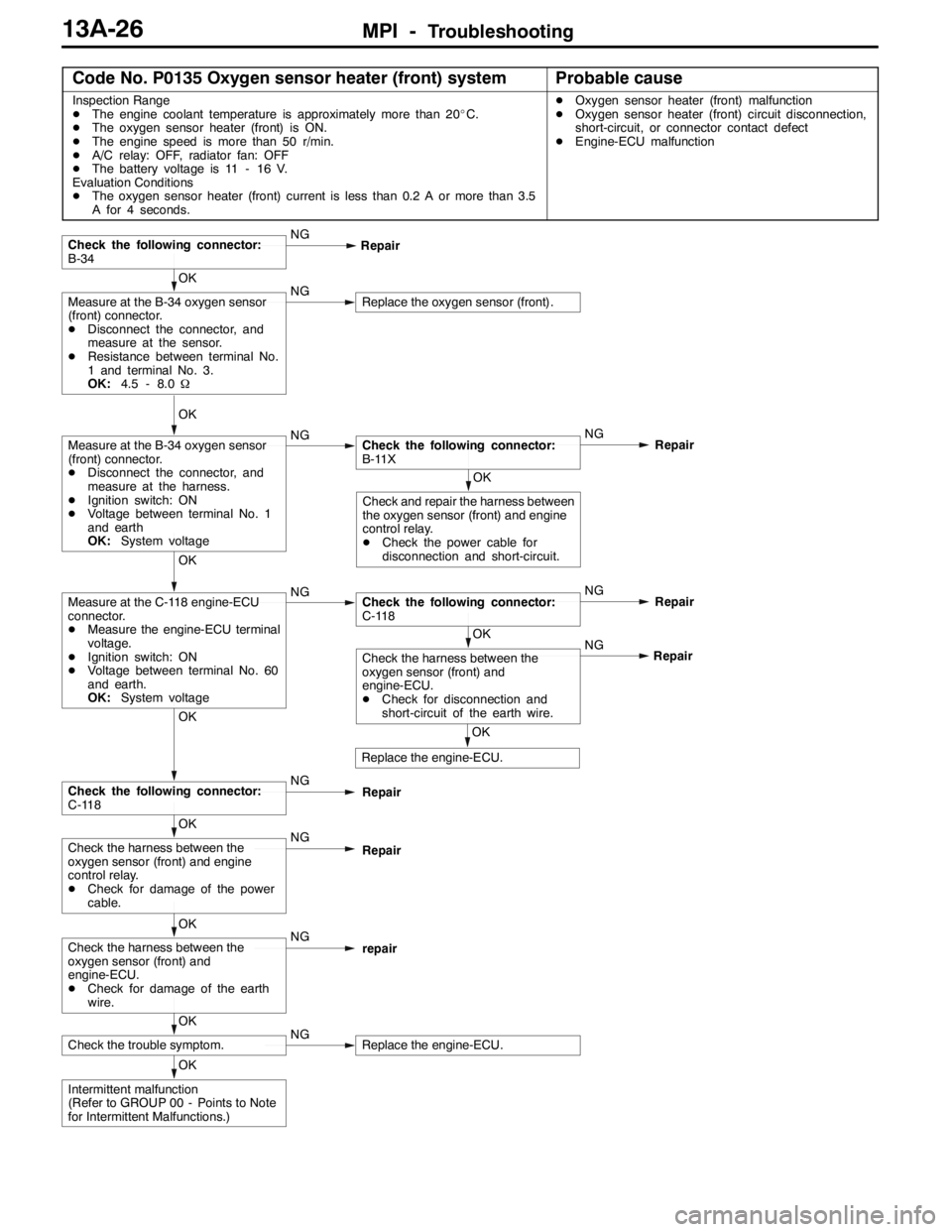
MPI -Troubleshooting13A-26
Code No. P0135 Oxygen sensor heater (front) systemProbable cause
Inspection Range
DThe engine coolant temperature is approximately more than 20_C.
DThe oxygen sensor heater (front) is ON.
DThe engine speed is more than 50 r/min.
DA/C relay: OFF, radiator fan: OFF
DThe battery voltage is 11 - 16 V.
Evaluation Conditions
DThe oxygen sensor heater (front) current is less than 0.2 A or more than 3.5
A for 4 seconds.DOxygen sensor heater (front) malfunction
DOxygen sensor heater (front) circuit disconnection,
short-circuit, or connector contact defect
DEngine-ECU malfunction
OK
Intermittent malfunction
(Refer to GROUP 00 - Points to Note
for Intermittent Malfunctions.)
OK
Check the trouble symptom.NGReplace the engine-ECU.
OK
Check the harness between the
oxygen sensor (front) and
engine-ECU.
DCheck for damage of the earth
wire.NG
repair
OK
Check the harness between the
oxygen sensor (front) and engine
control relay.
DCheck for damage of the power
cable.NG
Repair
OK
Check the following connector:
C-118NG
Repair
OK
Replace the engine-ECU.NG
OK
Check the harness between the
oxygen sensor (front) and
engine-ECU.
DCheck for disconnection and
short-circuit of the earth wire.Repair
OK
Measure at the C-118 engine-ECU
connector.
DMeasure the engine-ECU terminal
voltage.
DIgnition switch: ON
DVoltage between terminal No. 60
and earth.
OK:System voltageNGCheck the following connector:
C-118NG
Repair
OK
Check and repair the harness between
the oxygen sensor (front) and engine
control relay.
DCheck the power cable for
disconnection and short-circuit.
OK
Measure at the B-34 oxygen sensor
(front) connector.
DDisconnect the connector, and
measure at the harness.
DIgnition switch: ON
DVoltage between terminal No. 1
and earth
OK:System voltageNGCheck the following connector:
B-11XNG
Repair
OK
Measure at the B-34 oxygen sensor
(front) connector.
DDisconnect the connector, and
measure at the sensor.
DResistance between terminal No.
1 and terminal No. 3.
OK:4.5 - 8.0ΩNGReplace the oxygen sensor (front).
Check the following connector:
B-34NG
Repair
Page 559 of 1449
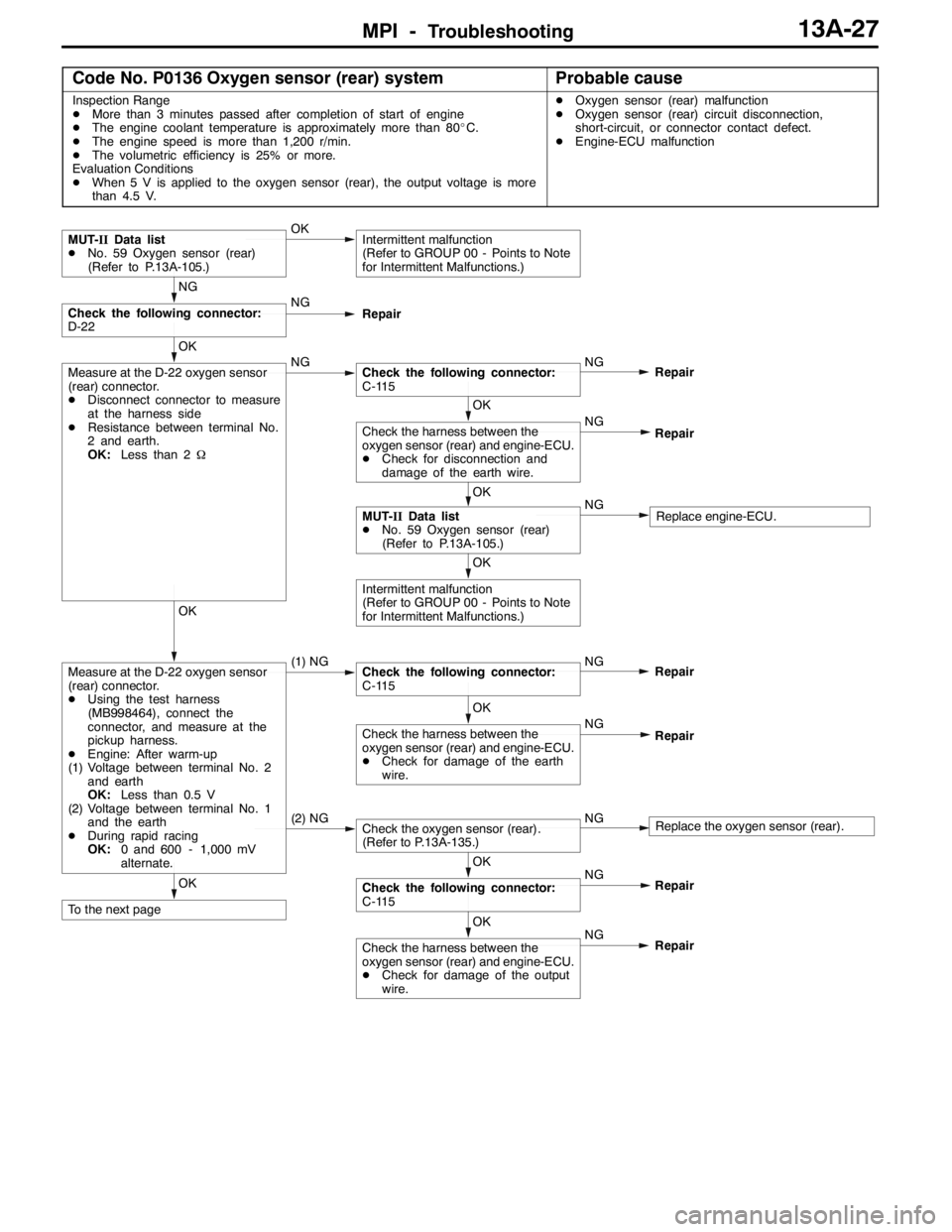
MPI -Troubleshooting13A-27
Code No. P0136 Oxygen sensor (rear) systemProbable cause
Inspection Range
DMore than 3 minutes passed after completion of start of engine
DThe engine coolant temperature is approximately more than 80_C.
DThe engine speed is more than 1,200 r/min.
DThe volumetric efficiency is 25% or more.
Evaluation Conditions
DWhen 5 V is applied to the oxygen sensor (rear), the output voltage is more
than 4.5 V.DOxygen sensor (rear) malfunction
DOxygen sensor (rear) circuit disconnection,
short-circuit, or connector contact defect.
DEngine-ECU malfunction
OK
To the next pageOK
Check the harness between the
oxygen sensor (rear) and engine-ECU.
DCheck for damage of the output
wire.NG
Repair NG
OK
Check the following connector:
C-115Repair
(2) NGCheck the oxygen sensor (rear).
(Refer to P.13A-135.)NGReplace the oxygen sensor (rear).
OK
Check the harness between the
oxygen sensor (rear) and engine-ECU.
DCheck for damage of the earth
wire.NG
Repair
OK
Measure at the D-22 oxygen sensor
(rear) connector.
DUsing the test harness
(MB998464), connect the
connector, and measure at the
pickup harness.
DEngine: After warm-up
(1) Voltage between terminal No. 2
and earth
OK:Less than 0.5 V
(2) Voltage between terminal No. 1
and the earth
DDuring rapid racing
OK:0 and 600 - 1,000 mV
alternate.(1) NGCheck the following connector:
C-115NG
Repair
OK
Intermittent malfunction
(Refer to GROUP 00 - Points to Note
for Intermittent Malfunctions.)
OK
MUT-IIData list
DNo. 59 Oxygen sensor (rear)
(Refer to P.13A-105.)NGReplace engine-ECU.
OK
Check the harness between the
oxygen sensor (rear) and engine-ECU.
DCheck for disconnection and
damage of the earth wire.NG
Repair
OK
Measure at the D-22 oxygen sensor
(rear) connector.
DDisconnect connector to measure
at the harness side
DResistance between terminal No.
2 and earth.
OK:Less than 2ΩNGCheck the following connector:
C-115NG
Repair
NG
Check the following connector:
D-22NG
Repair
MUT-IIData list
DNo. 59 Oxygen sensor (rear)
(Refer to P.13A-105.)OKIntermittent malfunction
(Refer to GROUP 00 - Points to Note
for Intermittent Malfunctions.)